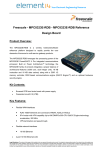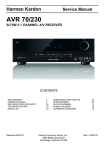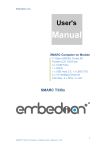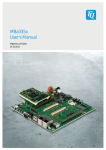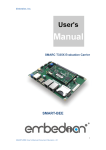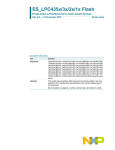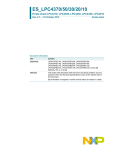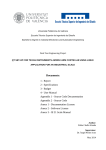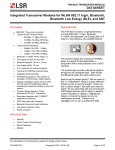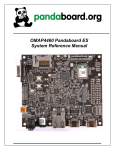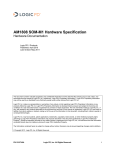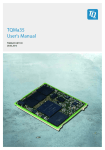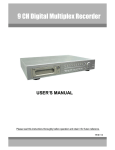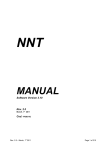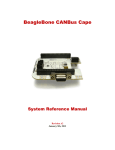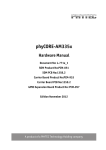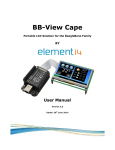Download User Manual
Transcript
TQMa335x Preliminary User's Manual TQMa335x UM 002 26.11.2013 Preliminary User's Manual l TQMa335x UM 002 l © 2013 TQ-Group Page i TABLE OF CONTENTS 1. 1.1 1.2 1.3 1.4 1.5 1.6 1.7 1.8 1.9 2. 2.1 3. 3.1 3.1.1 3.1.2 3.2 3.2.1 3.2.2 3.2.2.1 3.2.2.2 3.2.2.3 3.2.2.4 3.2.2.5 3.2.3 3.2.3.1 3.2.3.2 3.2.3.3 3.2.3.4 3.2.4 3.2.5 3.2.6 3.2.7 3.2.8 3.2.9 3.2.10 3.2.11 3.2.12 3.2.13 3.2.14 3.2.15 3.2.16 3.2.17 3.2.18 3.2.18.1 3.2.18.2 3.2.18.3 3.2.19 3.2.20 3.2.21 3.2.21.1 3.2.21.2 3.2.22 3.2.22.1 3.2.22.2 3.2.22.3 3.2.22.4 3.2.22.5 3.2.22.6 ABOUT THIS MANUAL ........................................................................................................................................................................1 Copyright and licence expenses.....................................................................................................................................................1 Registered trademarks.......................................................................................................................................................................1 Disclaimer ..............................................................................................................................................................................................1 Imprint ....................................................................................................................................................................................................1 Tips on safety ........................................................................................................................................................................................2 Symbols and typographic conventions........................................................................................................................................2 Handling and ESD tips........................................................................................................................................................................2 Naming of signals................................................................................................................................................................................3 Further applicable documents / presumed knowledge..........................................................................................................3 BRIEF DESCRIPTION.............................................................................................................................................................................4 Key functions and characteristics ...................................................................................................................................................4 ELECTRONICS SPECIFICATION .........................................................................................................................................................5 System overview..................................................................................................................................................................................5 System architecture / block diagram.............................................................................................................................................5 Functionality .........................................................................................................................................................................................5 System components...........................................................................................................................................................................6 AM335xprocessor................................................................................................................................................................................6 AM335x processor versions..............................................................................................................................................................6 Boot configuration ..............................................................................................................................................................................7 Boot interfaces......................................................................................................................................................................................7 Boot device SD card............................................................................................................................................................................7 Boot device eMMC ..............................................................................................................................................................................8 Boot device SPI NOR flash.................................................................................................................................................................8 Memory...................................................................................................................................................................................................9 DDR3L SDRAM......................................................................................................................................................................................9 eMMC NAND flash...............................................................................................................................................................................9 Serial NOR ........................................................................................................................................................................................... 10 EEPROM ............................................................................................................................................................................................... 10 Temperature sensor......................................................................................................................................................................... 11 RTC ........................................................................................................................................................................................................ 11 Ethernet ............................................................................................................................................................................................... 12 SD card................................................................................................................................................................................................. 13 GPIO ...................................................................................................................................................................................................... 13 JTAG...................................................................................................................................................................................................... 13 Touch and Analog Inputs............................................................................................................................................................... 14 External Memory Bus....................................................................................................................................................................... 14 LCD-Controller................................................................................................................................................................................... 15 Serial interfaces ................................................................................................................................................................................. 16 CAN ....................................................................................................................................................................................................... 16 I2C.......................................................................................................................................................................................................... 16 I2S .......................................................................................................................................................................................................... 17 SPI.......................................................................................................................................................................................................... 17 UART ..................................................................................................................................................................................................... 18 UART0................................................................................................................................................................................................... 18 UART3................................................................................................................................................................................................... 18 UART4................................................................................................................................................................................................... 19 USB........................................................................................................................................................................................................ 19 Reset ..................................................................................................................................................................................................... 20 Power supply ..................................................................................................................................................................................... 21 Main power supply........................................................................................................................................................................... 21 Overview module supply ............................................................................................................................................................... 21 Power Modes ..................................................................................................................................................................................... 21 RTC Backup......................................................................................................................................................................................... 21 AM335x RTC-Only............................................................................................................................................................................. 22 AM335x DEEP-SLEEP0-2, Standby ............................................................................................................................................... 22 AM335x Active Mode ...................................................................................................................................................................... 22 Module / carrier board Power-Up sequence............................................................................................................................ 23 Battery input VBACKUP................................................................................................................................................................... 23 Preliminary User's Manual l TQMa335x UM 002 l © 2013 TQ-Group Page ii TABLE OF CONTENTS (continued) 3.3 3.3.1 3.3.2 3.3.3 4. 4.1 4.2 4.3 4.4 4.5 4.6 4.7 4.8 5. 6. 6.1 6.2 6.3 6.4 6.5 6.6 6.6.1 6.6.2 6.7 6.8 7. 7.1 7.2 Module interface............................................................................................................................................................................... 23 Pin assignment.................................................................................................................................................................................. 23 Pinout connector X1........................................................................................................................................................................ 24 Pinout connector X2........................................................................................................................................................................ 25 MECHANICS........................................................................................................................................................................................ 26 Module connectors.......................................................................................................................................................................... 26 Dimensions......................................................................................................................................................................................... 27 Component placement .................................................................................................................................................................. 28 Adaptation to the environment................................................................................................................................................... 29 Protection against external effects ............................................................................................................................................. 29 Thermal management .................................................................................................................................................................... 29 Structural requirements ................................................................................................................................................................. 29 Notes of treatment........................................................................................................................................................................... 29 SOFTWARE .......................................................................................................................................................................................... 29 SAFETY REQUIREMENTS AND PROTECTIVE REGULATIONS ................................................................................................. 30 EMC ....................................................................................................................................................................................................... 30 ESD ........................................................................................................................................................................................................ 30 Operational safety and personal security ................................................................................................................................. 30 Climatic and operational conditions .......................................................................................................................................... 30 Reliability and service life............................................................................................................................................................... 31 Environment protection................................................................................................................................................................. 31 RoHS compliance.............................................................................................................................................................................. 31 WEEE regulation................................................................................................................................................................................ 31 Batteries............................................................................................................................................................................................... 31 Other entries ...................................................................................................................................................................................... 31 APPENDIX............................................................................................................................................................................................ 32 Acronyms and definitions.............................................................................................................................................................. 32 References........................................................................................................................................................................................... 34 Preliminary User's Manual l TQMa335x UM 002 l © 2013 TQ-Group Page iii TABLE DIRECTORY Table 1: Table 2: Table 3: Table 4: Table 5: Table 6: Table 7: Table 8: Table 9: Table 10: Table 11: Table 12: Table 13: Table 14: Table 15: Table 16: Table 17: Table 18: Table 19: Table 20: Table 21: Table 22: Table 23: Table 24: Table 25: Table 26: Table 27: Table 28: Table 29: Table 30: Table 31: Table 32: Table 33: Table 34: Table 35: Table 36: Table 37: Table 38: Table 39: Table 40: Table 41: Terms and Conventions.....................................................................................................................................................................2 Processor versions...............................................................................................................................................................................6 Boot device selection .........................................................................................................................................................................7 Oscillator frequency............................................................................................................................................................................7 Pins used for SD card boot................................................................................................................................................................7 Pins used for eMMC boot..................................................................................................................................................................8 Pins used for SPI NOR flash boot.....................................................................................................................................................8 DDR3 SDRAM ........................................................................................................................................................................................9 DDR3-SDRAM address range ...........................................................................................................................................................9 EEPROM ............................................................................................................................................................................................... 10 Temperature sensor......................................................................................................................................................................... 11 Current consumption RTC ............................................................................................................................................................. 11 RGMII1 .................................................................................................................................................................................................. 12 RGMII2 .................................................................................................................................................................................................. 12 SD card signals................................................................................................................................................................................... 13 GPIO signals........................................................................................................................................................................................ 13 JTAG signals........................................................................................................................................................................................ 13 Touch signals ..................................................................................................................................................................................... 14 LCD signals ......................................................................................................................................................................................... 15 CAN1 / CAN2 signals........................................................................................................................................................................ 16 I2C2 signals......................................................................................................................................................................................... 16 I2C2 address distribution ............................................................................................................................................................... 16 I2S signals............................................................................................................................................................................................ 17 SPI signals............................................................................................................................................................................................ 17 UART0 signals .................................................................................................................................................................................... 18 UART3 signals .................................................................................................................................................................................... 18 UART4 signals .................................................................................................................................................................................... 19 USB_H1 signals.................................................................................................................................................................................. 19 Reset signals....................................................................................................................................................................................... 20 Parameter module supply ............................................................................................................................................................. 21 External RTC ....................................................................................................................................................................................... 21 PMIC RTC ............................................................................................................................................................................................. 21 AM335x RTC-Only............................................................................................................................................................................. 22 AM335x DEEP-SLEEP0-2, Standby ............................................................................................................................................... 22 AM335x Active Mode ...................................................................................................................................................................... 22 Pinout connector X1........................................................................................................................................................................ 24 Pinout connector X2........................................................................................................................................................................ 25 Plug connector (receptacle) used on the TQMa335x ............................................................................................................ 26 Suitable carrier board mating plug connectors...................................................................................................................... 26 Acronyms ............................................................................................................................................................................................ 32 Further applicable documents..................................................................................................................................................... 34 Preliminary User's Manual l TQMa335x UM 002 l © 2013 TQ-Group Page iv ILLUSTRATION DIRECTORY Illustration 1: Illustration 2: Illustration 3: Illustration 4: Illustration 5: Illustration 6: Illustration 7: Illustration 8: Illustration 9: Illustration 10: Illustration 11: Illustration 12: Illustration 13: Illustration 14: Illustration 15: Illustration 16: Illustration 17: Block diagram TQMa335x (simplified)...................................................................................................................................4 Block diagram TQMa335x..........................................................................................................................................................5 Block diagram AM335x...............................................................................................................................................................6 Block diagram DDR3L SDRAM connection...........................................................................................................................9 Block diagram eMMC flash connection.................................................................................................................................9 Block diagram SPI NOR flash connection........................................................................................................................... 10 Block diagram EEPROM connection.................................................................................................................................... 10 Block diagram temperature sensor connection .............................................................................................................. 11 Block diagram UART0 interface ............................................................................................................................................ 18 Block diagram UART3 interface ............................................................................................................................................ 18 Block diagram UART4 interface ............................................................................................................................................ 19 Block diagram Reset ................................................................................................................................................................. 20 Block diagram power supply ................................................................................................................................................. 21 Block diagram power supply carrier board....................................................................................................................... 23 Overall dimensions (top view)............................................................................................................................................... 27 Component placement top ................................................................................................................................................... 28 Component placement bottom ........................................................................................................................................... 28 Preliminary User's Manual l TQMa335x UM 002 l © 2013 TQ-Group REVISION HISTORY Rev. Date Name 001 09.09.2013 Petz 002 26.11.2013 Petz Pos. Modification Preliminary document created All Complete rework Page v Preliminary User's Manual l TQMa335x UM 002 l © 2013 TQ-Group 1. ABOUT THIS MANUAL 1.1 Copyright and licence expenses Page 1 Copyright protected © 2013 by TQ-Systems GmbH. This Preliminary User's Manual may not be copied, reproduced, translated, changed or distributed, completely or partially in electronic, machine readable, or in any other form without the written consent of TQ-Systems GmbH. The drivers and utilities for the used components as well as the BIOS are subject to the copyrights of the respective manufacturers. The licence conditions of the respective manufacturer are to be adhered to. Bootloader-licence expenses are paid by TQ-Systems GmbH and are included in the price. Licence expenses for the operating system and applications are not taken into consideration and must be separately calculated / declared. 1.2 Registered trademarks TQ-Systems GmbH aims to adhere to the copyrights of all the graphics and texts used in all publications, and strives to use original or license-free graphics and texts. All the brand names and trademarks mentioned in the publication, including those protected by a third party, unless specified otherwise in writing, are subjected to the specifications of the current copyright laws and the proprietary laws of the present registered proprietor without any limitation. One should conclude that brand and trademarks are rightly protected by of a third party. 1.3 Disclaimer TQ-Systems GmbH does not guarantee that the information in this Preliminary User's Manual is up-to-date, correct, complete or of good quality. Nor does TQ-Systems GmbH assume guarantee for further usage of the information. Liability claims against TQSystems GmbH, referring to material or non-material related damages caused, due to usage or non-usage of the information given in the Preliminary User's Manual, or due to usage of erroneous or incomplete information, are exempted, as long as there is no proven intentional or negligent fault of TQ-Systems GmbH. TQ-Systems GmbH explicitly reserves the rights to change or add to the contents of this Preliminary User's Manual or parts of it without special notification. 1.4 Imprint TQ-Systems GmbH Gut Delling, Mühlstraße 2 82229 Seefeld Tel: +49 (0) 8153 9308–0 Fax: +49 (0) 8153 9308–134 Email: info@tqs.de http://www.tq-group.com/ Web: Preliminary User's Manual l TQMa335x UM 002 l © 2013 TQ-Group 1.5 Page 2 Tips on safety Improper or incorrect handling of the product can substantially reduce its life span. 1.6 Symbols and typographic conventions Table 1: Symbol Terms and Conventions Meaning This symbol represents the handling of electrostatic-sensitive modules and / or components. These components are often damaged / destroyed by the transmission of a voltage higher than about 50 V. A human body usually only experiences electrostatic discharges above approximately 3,000 V. This symbol indicates the possible use of voltages higher than 24 V. Please note the relevant statutory regulations in this regard. Non-compliance with these regulations can lead to serious damage to your health and also cause damage / destruction of the component. This symbol indicates a possible source of danger. Acting against the procedure described can lead to possible damage to your health and / or cause damage / destruction of the material used. This symbol represents important details or aspects for working with TQ-products. Command 1.7 A font with fixed-width is used to denote commands, file names, or menu items. Handling and ESD tips General handling of your TQ-products The TQ-product may only be used and serviced by certified personnel who have taken note of the information, the safety regulations in this document and all related rules and regulations. A general rule is: do not touch the TQ-product during operation. This is especially important when switching on, changing jumper settings or connecting other devices without ensuring beforehand that the power supply of the system has been switched off. Violation of this guideline may result in damage / destruction of the TQMa335x and be dangerous to your health. Improper handling of your TQ-product would render the guarantee invalid. Proper ESD handling The electronic components of your TQ-product are sensitive to electrostatic discharge (ESD). Always wear antistatic clothing, use ESD-safe tools, packing materials etc., and operate your TQproduct in an ESD-safe environment. Especially when you switch modules on, change jumper settings, or connect other devices. Preliminary User's Manual l TQMa335x UM 002 l © 2013 TQ-Group 1.8 Page 3 Naming of signals A hash mark (#) at the end of the signal name indicates a low-active signal. Example: RESET# If a signal can switch between two functions and if this is noted in the name of the signal, the low-active function is marked with a hash mark and shown at the end. Example: C / D# If a signal has multiple functions, the individual functions are separated by slashes when they are important for the wiring. The identification of the individual functions follows the above conventions. Example: WE2# / OE# 1.9 Further applicable documents / presumed knowledge • • • • • Specifications and manual of the used modules: These documents describe the service, functionality and special characteristics of the used module (incl. BIOS). Specifications of the used components: The manufacturer's specifications of the used components, for example CompactFlash cards, are to be taken note of. They contain, if applicable, additional information that must be taken note of for safe and reliable operation. These documents are stored at TQ-Systems GmbH. Chip errata: It is the user's responsibility to make sure all errata published by the manufacturer of each component are taken note of. The manufacturer’s advice should be followed. Software behaviour: No warranty can be given, nor responsibility taken for any unexpected software behaviour due to deficient components. General expertise: Expertise in electrical engineering / computer engineering is required for the installation and the use of the device. The following documents are required to fully comprehend the following contents: • • • • • Circuit diagram MBa335x CPU Reference Manual SPRS717F Preliminary User's Manual STK-MBa335x Documentation of boot loader U-Boot Documentation of PTXdist (http://www.denx.de/wiki/U-Boot/Documentation) (http://www.ptxdist.de) Preliminary User's Manual l TQMa335x UM 002 l © 2013 TQ-Group 2. Page 4 BRIEF DESCRIPTION This Preliminary User's Manual describes the hardware of the TQMa335x, and refers to some software settings. It does not replace the Reference Manual of the CPU. The TQMa335x is a universal Minimodule based on the Texas Instruments AM335x. The Cortex A8 core of this CPU works with up to 800 MHz. The TQMa335x extends the TQC product range and offers an outstanding computing performance. Illustration 1: Block diagram TQMa335x (simplified) The TQMa335x provides the following key functions and characteristics: 2.1 Key functions and characteristics • • • • • • • • • • • • • • • • DDR3L SDRAM SPI NOR flash eMMC flash Up to 2 × Ethernet 10/100/1000 Mbit (L2 Switch) Up to 2 × CAN 2.0B Up to 6 × UART 2 × USB 2.0 High-Speed interface with PHY Up to 2 × SDIO/MMC Up to 3 × I2C Up to 2 × McASP (4-ch) Up to 2 × SPI GPIOs Up to 8 × 12 bit ADC channels Up to 3 × PWM 24 bit graphics for displays incl. backlight control (PWM), BKL on/off Touch (4-wire resistive) All useful signals of the microprocessor are routed to the connectors. There are no restrictions for customers using the TQMa335x with respect to an integrated customised design. Please take note of that not all listed interfaces can be used simultaneously. Preliminary User's Manual l TQMa335x UM 002 l © 2013 TQ-Group 3. ELECTRONICS SPECIFICATION 3.1 System overview 3.1.1 System architecture / block diagram Illustration 2: 3.1.2 Block diagram TQMa335x Functionality The following key functions are implemented on the TQMa335x: • • • • • • • • AM335x CPU (-2, -4, -8, -9) other on request DDR3L SDRAM, up to 512 Mbyte eMMC NAND flash, up to 16 Gbyte SPI NOR flash, up to 128 Mbyte EEPROM, 0 or 64 Kbyte (assembly option) Temperature sensor PMIC RTC Page 5 Preliminary User's Manual l TQMa335x UM 002 l © 2013 TQ-Group 3.2 System components 3.2.1 AM335xprocessor Page 6 The following illustration shows the block diagram of the AM335x processor family: Illustration 3: 3.2.2 Block diagram AM335x (Source: Texas Instruments) AM335x processor versions Depending on the version of the TQMa335x one of the following versions of the CPU is assembled: Table 2: Processor versions Manufacturer Part number Temperature range Package Texas Instruments AM3352BZCZD80 –40 °C to +90 °C PBGA324 (ZCZ) Texas Instruments AM3354BZCZD80 –40 °C to +90 °C PBGA324 (ZCZ) Texas Instruments AM3359BZCZA80 –40 °C to +105 °C PBGA324 (ZCZ) Attention: Malfunction Please take note of the current errata of the AM335x (7). Preliminary User's Manual l TQMa335x UM 002 l © 2013 TQ-Group 3.2.2.1 Page 7 Boot configuration The boot configuration of the TQMa335x is defined through 16 GPIO pins. None of these 16 boot configuration pins are connected on the TQMa335x, which means, the TQMa335x is delivered with no preset boot configuration. The boot-configuration is read from register sysboot[15:0]. Register sysboot is read from pins LCD_DATA[15:0]. It is recommended to connect 10 kΩ pull-up or pull-down resistors. The settings for other boot devices are to be taken from the data sheet of the AM335x CPU (1). The following tables shows the configuration which can be used with the BSP and the MBA335x of TQ-Systems GmbH. Table 3: Boot device selection SYSBOOT[4:0] Boot Sequence 1st 2nd 3rd 4th 10111b MMC0 / SD MCSPI0 / NOR UART0 / n.a. USB0 / n.a. 11100b MMC1/ eMMC MMC0 / SD UART0 / n.a. USB0 / n.a. 11000b MCSPI0 / NOR MMC0 / SD USB0 / n.a. UART0 / n.a. The bits SYSBOOT[15:14] set the frequency of the oscillator. The values in the following table printed in bold are used on account of the 24 MHz oscillator assembled on the TQMa335x. Table 4: Oscillator frequency SYSBOOT[15:14] Oscillator frequency / MHz Remark 00b 19.2 – 01b 24 Default 10b 25 – 11b 26 – Bit SYSBOOT[5] indicates whether CLKOUT1is configured as an output after a reset. This can be set accordingly. The remaining values of SYSBOOT[13:6] have to be set to “0”. These settings exclusively support the above described boot sequences. 3.2.2.2 Boot interfaces The configuration of the following boot devices is described in the next sections: • MMC0 (external SD card) • MCSPI0 (internal NOR flash) • MMC1 (internal eMMC) 3.2.2.3 Boot device SD card The SD card boots from MMC0. The boot ROM does not support card_detect. Booting from SD card supports the binary raw mode and FAT. The following pins must be used for the boot process. Table 5: Pins used for SD card boot Signal name Pin used in device CLK CMD DAT0 DAT1 DAT2 DAT3 MMC0_CLK MMC0_CMD MMC0_DAT0 MMC0_DAT1 MMC0_DAT2 MMC0_DAT3 Preliminary User's Manual l TQMa335x UM 002 l © 2013 TQ-Group 3.2.2.4 Page 8 Boot device eMMC The eMMC boots from MMC1. MMC1supports eMMCs with a memory size of 4 Gbyte or greater. Booting from eMMC supports the binary raw mode and FAT. The maximum bus width to boot from is 4 bits, initially it is 1 bit. The following pins have to be used for the boot process. Table 6: Pins used for eMMC boot Signal name Pin used in device Remark CLK GPMC_CSN1 – CMD GPMC_CSN2 – DAT0 GPMC_AD0 4-bit boot DAT1 GPMC_AD1 4-bit boot DAT2 GPMC_AD2 4-bit boot DAT3 GPMC_AD3 4-bit boot DAT4 GPMC_AD4 Not for booting DAT5 GPMC_AD5 Not for booting DAT6 GPMC_AD6 Not for booting DAT7 GPMC_AD7 Not for booting 3.2.2.5 Boot device SPI NOR flash The SPI flash has to be connected to SPI0 / CS0. 12 MHz (50% duty cycle) are supported. Only SPI mode 3 is supported (SPICLK active low, sampling with rising edge). The SPI-FLASH has to be 24 bits addressable and has to support the command “read 03h“. The following pins have to be used for the boot process. Table 7: Pins used for SPI NOR flash boot Signal name Pin used in device CS SPI0_CS0 MISO SPI0_D0 MOSI SPI0_D1 CLK SPI0_SCLK HOLD# WARMRST# For other boot-configurations please refer to the data sheet of the AM335x CPU (1). Attention: Destruction or malfunction Many of the CPU pins permit the usage of several different configurations. Please pay attention to the notes in the data sheet of the AM335x CPU (1) concerning the wiring of these pins before integration / start-up of your carrier board / Starterkit. Preliminary User's Manual l TQMa335x UM 002 l © 2013 TQ-Group 3.2.3 3.2.3.1 Memory DDR3L SDRAM The TQMa335x is equipped with one DDR3L SDRAM chip with a data bus width of 16 bits. The following block diagram shows how the DDR3L SDRAM is connected to the processor. Illustration 4: Block diagram DDR3L SDRAM connection The TQMa335x can be equipped with 256 Mibyte or 512 Mibyte of DDR3L SDRAM: Table 8: DDR3 SDRAM Placement option Size Remark 1 × DDR3L 128M16 256 Mibyte – 1 × DDR3L 256M16 512 Mibyte – The SDRAM is mapped to the following address: Table 9: DDR3-SDRAM address range Start address Range Chip Select Remark 0x8000_0000 0x4000_0000 CS0# – 3.2.3.2 eMMC NAND flash The eMMC NAND flash on the TQMa335x contains the boot loader and the application software. The BSP provided by TQ-Systems GmbH supports a clock rate of 48 MHz. The following block diagram shows how the eMMC flash is connected to the processor. Illustration 5: Block diagram eMMC flash connection Page 9 Preliminary User's Manual l TQMa335x UM 002 l © 2013 TQ-Group 3.2.3.3 Serial NOR Optionally the TQMa335x can be equipped with an SPI NOR flash. It can, e.g., be used as a recovery device. The following block diagram shows how the SPI NOR flash is connected to the processor. Illustration 6: Block diagram SPI NOR flash connection The write protection pin of the SPI NOR flash is not routed to the connector. 3.2.3.4 EEPROM For permanent storage of e.g. module characteristics or customers parameters a serial EEPROM is available. The EEPROM is controlled via I2C bus 0 of the processor. The write protection pin (WP) of the EEPROM is not available. The following block diagram shows how the EEPROM is connected to the processor. Illustration 7: Block diagram EEPROM connection The following table shows the EEPROM used. Table 10: EEPROM Manufacturer Part number Size Temperature range STM M24C64-WDW6TP 64 kbit –40 °C to +85 °C The I2C address of the EEPROM is 0x50 / 0b101 0000. Page 10 Preliminary User's Manual l TQMa335x UM 002 l © 2013 TQ-Group 3.2.4 Page 11 Temperature sensor A temperature sensor for supervision of the module temperature is provided on the TQMa335x. The sensor is placed on the bottom side of the module (D8 in Illustration 17). The temperature sensor is connected to the I2C bus 0 of the processor. The overtemperature detection output of the sensor is not connected to the CPU. The following block diagram shows how the temperature sensor is connected to the processor. Illustration 8: Block diagram temperature sensor connection The following table shows the temperature sensor used. Table 11: Temperature sensor Manufacturer NXP Part number SE97BTP Remark 11 bit ADC Error Max. ±1 °C Temperature range –40 °C to +125 °C The I2C address of the temperature sensor is 0x1F / 0b001 1111. 3.2.5 RTC Both the AM335x and the PMIC on the TQMa335x provide an RTC. The RTC pins of the PMIC are routed to the module connector (VBACKUP_PMIC) to connect a backup supply. For the RTC to work reliably the voltage at pin “VBACKUP_PMIC” has to be in the range of 2.3 V to 3.0 V. The RTC used depends on the software implementation. More details are to be taken from the Texas Instruments Reference Manual of the CPU and the PMIC. The accuracy of the RTC is mainly determined by the characteristics of the quartz used. The type FC-135 used on the TQMa335x has a standard frequency tolerance of ±20 ppm @ 25 °C. (Parabolic coefficient: max. –0.04 × 10–6 / °C2). An optional RTC DS1339U-33 is also available. This optional RTC is supplied through pin VBACKUP_RTC. The PMIC on the TQMa335x provides a backup supply voltage. It supports coin cells, Lithium coin cells or Supercapacitors. Charging methods and electrical characteristics of the pin VBACKUP_RTC of the PMIC are to be taken from the User’s Guide of the PMIC TPS65910 (6). The typical current consumption of the different RTCs is shown in the following table: Table 12: Current consumption RTC RTC Typical current consumption Remark PMIC RTC Approximately 6.0 µA – CPU RTC >5 mA Supply has to be configured in PMIC DS1339U-33 400 nA to 700 nA – Preliminary User's Manual l TQMa335x UM 002 l © 2013 TQ-Group 3.2.6 Page 12 Ethernet The AM335x provides two 10/100/1000 Mbit Fast Ethernet Controller using the RGMII. The following table shows the signals used by the Fast Ethernet Controllers. Table 13: RGMII1 Pin Signal Pad Dir. Ball Remark X2_23 RGMII1_TCLK MMI1_TX_CLK I/O K18 – X2_24 RGMII1_RCLK MMI1_RX_CLK I/O L18 – X2_27 RGMII1_TCTL MMI1_TX_EN I/O J16 – X2_28 RGMII1_RCTL MMI1_RX_DV I/O J17 – X2_29 RGMII1_TD0 MMI1_TXD0 I/O K17 – X2_30 RGMII1_RD0 MMI1_RXD0 I/O M16 – X2_31 RGMII1_TD1 MMI1_TXD1 I/O K16 – X2_32 RGMII1_RD1 MMI1_RXD1 I/O L15 – X2_33 RGMII1_TD2 MMI1_TXD2 I/O K15 – X2_34 RGMII1_RD2 MMI1_RXD2 I/O L16 – X2_35 RGMII1_TD3 MMI1_TXD3 I/O J18 – X2_36 RGMII1_RD3 MMI1_RXD3 I/O L17 – Table 14: RGMII2 Pin Signal Pad Dir. Ball Remark X2_45 RGMII2_TCLK GPMC_A6 I/O U15 – X2_46 RGMII2_RCLK GPMC_A7 I/O T15 – X2_49 RGMII2_TCTL GPMC_A0 I/O R13 – X2_50 RGMII2_RCTL GPMC_A1 I/O V14 – X2_51 RGMII2_TD0 GPMC_A5 I/O V15 – X2_52 RGMII2_RD0 GPMC_A11 I/O V17 – X2_53 RGMII2_TD1 GPMC_A4 I/O R14 – X2_54 RGMII2_RD1 GPMC_A10 I/O T16 – X2_55 RGMII2_TD2 GPMC_A3 I/O T14 – X2_56 RGMII2_RD2 GPMC_A9 I/O U16 – X2_57 RGMII2_TD3 GPMC_A2 I/O U14 – X2_58 RGMII2_RD3 GPMC_A8 I/O V16 – Preliminary User's Manual l TQMa335x UM 002 l © 2013 TQ-Group 3.2.7 Page 13 SD card An SD card can be connected to the TQMa335x. The MMC controller is routed to the module connectors for this purpose. The MMC interface supports SD and SDIO as well. The following table shows the signals used by the SD card interface. Table 15: SD card signals Pin Signal Pad Dir. Ball Remark X1_35 MMC0_DAT0 MMC0_DAT0 I/O G16 – X1_36 MMC0_DAT2 MMC0_DAT2 I/O F18 – X1_37 MMC0_DAT1 MMC0_DAT1 I/O G15 – X1_38 MMC0_DAT3 MMC0_DAT3 I/O F17 – X1_41 MMC0_CLK MMC0_CLK I/O G17 – X1_42 MMC0_CMD MMC0_CMD I/O G18 – The supported modes of operation, as well as MMC specifications are to be taken from the data sheet of the AM335x CPU (1). If desired port MMC0 can be configured as a boot device. The control signals MMC0_CD# and MMC0_WP# are multiplexed with UART3 signal RxD and TxD. 3.2.8 GPIO Besides their interface function most of the pins of the AM335x can also be used as GPIOs. All these GPIOs are interrupt and therefore wake-up capable. Details are to be taken from the data sheet of the AM335x CPU (1). Moreover several pins marked as GPIO are already routed to the module connectors. The following table shows the signals which can be used as GPIOs. Table 16: GPIO signals Pin Signal Pad Dir. Ball Remark X1_7 GPIO1_28 GPMC_BE#1 I/O U18 – X1_9 GPIO1_29 GPMC_CS#0 I/O V6 – X1_11 GPIO2_0 GPMC_CS#3 I/O T13 – The electrical characteristics of the GPIOs are to be taken from the respective data sheets provided by Texas Instruments (2) / (3). 3.2.9 JTAG The JTAG interface of the AM335x is routed to the module connectors. The following table shows the signals used by the JTAG interface. Table 17: JTAG signals Pin Signal Pad Dir. Ball Remark X1_99 TDO TDO O A11 – X1_101 TDI TDI I B11 – X1_103 TMS TMS I C11 – X1_106 TCK TCK I A12 – X1_98 TRST# TRST# I B10 – X1_100 EMU1 EMU1 I/O B14 – X1_102 EMU0 EMU0 I/O C14 – Preliminary User's Manual l TQMa335x UM 002 l © 2013 TQ-Group 3.2.10 Page 14 Touch and Analog Inputs The AM335x provides several analog inputs including a touch interface. These inputs are routed to the module connectors. A resistive 4-wire touch can be connected for instance. The following table shows the signals used by the analog interface. Table 18: Touch signals Pin Signal Pad Dir. Ball Remark X1_71 AIN7 AIN7 A C9 – X1_72 AIN3 AIN3 A A7 Y– X1_73 AIN6 AIN6 A A8 – X1_74 AIN2 AIN2 A B7 Y+ X1_77 AIN5 AIN5 A B8 – X1_78 AIN1 AIN1 A C7 X– X1_79 AIN4 AIN4 A C8 – X1_80 AIN0 AIN0 A B6 X+ Wake-up by touch is possible. The implementation and the selection of a certain power mode depends on the respective software. 3.2.11 External Memory Bus Address and data bus, as well as control signals of the external memory interface of the AM335x are routed to the module connectors. The interface is multiplexed with internal boot medium eMMC, LCD, RGMII2 and UART4. However these pins are routed to the module connectors. Preliminary User's Manual l TQMa335x UM 002 l © 2013 TQ-Group 3.2.12 Page 15 LCD-Controller The LCD-Controller of the AM335x supports up to 24-bit (RGB) and a resolution of up to WXGA (1366 × 768). All necessary pins are routed to the module connectors. The following table shows the signals used, as well as their characteristics. Table 19: LCD signals Pin Signal Pad Dir. Ball Remark X2_75 LCD_MCLK GPMC_CLK I/O V12 – X2_76 LCD_HSYNC LCD_HSYNC I/O R5 – X2_78 LCD_VSYNC LCD_VSYNC I/O U5 – X2_79 LCD_PCLK LCD_PCLK I/O V5 – X2_80 LCD_AC_BIAS_EN LCD_AC_BIAS_EN I/O R6 – X2_83 LCD_DATA23 GPMC_AD8 I/O U10 – X2_84 LCD_DATA22 GPMC_AD9 I/O T10 – X2_85 LCD_DATA21 GPMC_AD10 I/O T11 – X2_86 LCD_DATA20 GPMC_AD11 I/O U12 – X2_87 LCD_DATA19 GPMC_AD12 I/O T12 – X2_88 LCD_DATA18 GPMC_AD13 I/O R12 – X2_89 LCD_DATA17 GPMC_AD14 I/O V13 – X2_90 LCD_DATA16 GPMC_AD15 I/O U13 – X2_93 LCD_DATA15 LCD_DATA15 I/O T5 – X2_94 LCD_DATA14 LCD_DATA14 I/O V4 – X2_95 LCD_DATA13 LCD_DATA13 I/O V3 – X2_96 LCD_DATA12 LCD_DATA12 I/O V2 – X2_97 LCD_DATA11 LCD_DATA11 I/O U4 – X2_98 LCD_DATA10 LCD_DATA10 I/O U3 – X2_99 LCD_DATA9 LCD_DATA9 I/O U2 – X2_100 LCD_DATA8 LCD_DATA8 I/O U1 – X2_103 LCD_DATA7 LCD_DATA7 I/O T4 – X2_104 LCD_DATA6 LCD_DATA6 I/O T3 – X2_105 LCD_DATA5 LCD_DATA5 I/O T2 – X2_106 LCD_DATA4 LCD_DATA4 I/O T1 – X2_107 LCD_DATA3 LCD_DATA3 I/O R4 – X2_108 LCD_DATA2 LCD_DATA2 I/O R3 – X2_109 LCD_DATA1 LCD_DATA1 I/O R2 – X2_110 LCD_DATA0 LCD_DATA0 I/O R1 – Preliminary User's Manual l TQMa335x UM 002 l © 2013 TQ-Group 3.2.13 Page 16 Serial interfaces The supported standards, transfer modes and rates of the following interfaces are to be taken from the data sheet of the AM335x CPU (1). 3.2.14 CAN The AM335x provides two integrated CAN controller. The signals of both CAN controllers are routed to the module connectors. The drivers have to be integrated on the carrier board. The following table shows the signals used, as well as their characteristics. Table 20: CAN1 / CAN2 signals Pin Signal Pad Dir. Ball Remark X1_51 DCAN0_TX UART1_CTS# I/O D18 – X1_53 DCAN0_RX UART1_RTS# I/O D17 – X1_52 DCAN1_TX UART0_CTS# I/O E18 – X1_54 DCAN1_RX UART0_RTS# I/O E17 – 3.2.15 I2C The AM335x provides three I2C interfaces. The I2C interfaces I2C0 and I2C1 are routed to the module connectors. The following table shows the signals used, as well as their characteristics. Table 21: I2C2 signals Pin Signal Pad Dir. Ball Remark X2_17 I2C0_SDA I2C0_SDA I/O C17 – X2_19 I2C0_SCL I2C0_SCL I/O C16 – X1_91 I2C1_SDA UART1_RXD I/O D16 – X1_92 I2C1_SCL UART1_TXD I/O D15 – The following devices are connected to the I2C0 bus on the TQMa335x: Table 22: I2C2 address distribution Device Chosen address RTC (DS1339, optional) 0x68 / 0b110 1000 EEPROM (M24C64) 0x50 / 0b101 0000 EEPROM SW PROTECT (SE97BTP) EEPROM (SE97BTP) Temperature sensor (SE97BTP) 0x37 / 0b011 0111 0x57 / 0b101 0111 0x1F / 0b001 1111 PMIC (TPS65910) 0x12 / 0b001 0010 0x2D / 0b010 1101 In case more devices have to be connected to the I2C2 bus on the carrier board, the maximum capacitive bus load accordingly to the I2C standard has to be adhered to. If required additional pull-ups should be provided on the carrier board at the bus. Preliminary User's Manual l TQMa335x UM 002 l © 2013 TQ-Group 3.2.16 Page 17 I2S To connect an audio-codec via I2S signals of the Multichannel Audio Serial Port (MCASP) are routed to the module connectors. The following table shows the signals used by the I2S interface. Table 23: 3.2.17 I2S signals Pin Signal Pad Dir. Ball Remark X1_61 MCASP0_AXR0 MCASP0_AXR0 I/O D12 – X1_62 MCASP0_FSR MCASP0_FSR I/O C13 – X1_63 MCASP0_AXR1 MCASP0_AXR1 I/O D13 – X1_64 MCASP0_FSX MCASP0_FSX I/O B13 – X1_65 MCASP0_AXR2 MCASP0_AXR2 I/O C12 – X1_66 MCASP0 ACLKR MCASP0 ACLKR I/O B12 – X1_67 MCASP0_AXR3 MCASP0_AXR3 I/O A14 – X1_68 MCASP0 ACLKX MCASP0 ACLKX I/O A13 – SPI The AM335x provides two MCSPIs (Multichannel Serial Port Interface). Both interfaces are routed to the module connectors. MCSPI0 is connected to the optional boot medium SPI-NOR Flash on the TQMa335x. Table 24: SPI signals Pin Signal Pad Dir. Ball Remark X1_45 SPI1_D0 MII1_CRS I/O H17 – X1_46 SPI1_D1 MII1_RX_ER I/O J15 – X1_47 SPI1_SCLK MII1_COL I/O H16 – X1_48 SPI1_CS0 RMII1_REF_CLK I/O H18 – X1_83 SPI0_D0 SPI0_D0 I/O B17 – X1_84 SPI0_D1 SPI0_D1 I/O B16 – X1_85 SPI0_SCLK SPI0_SCLK I/O A17 – X1_86 SPI0_CS0 SPI0_CS0 I/O A16 – Port MCSPI0 can be configured as boot device. In this case signal CS0# has to be used as slave select. Preliminary User's Manual l TQMa335x UM 002 l © 2013 TQ-Group 3.2.18 Page 18 UART The AM335x provides five UART interfaces. UART0 and UART4 are routed to the module connectors. 3.2.18.1 UART0 The UART0 interface also provides handshake signals. AM335x Module plug connector UART0_TX UART0_RX UART0_RTS# UART0_CTS# Illustration 9: UART0_TX UART0_RX UART0_RTS# UART0_CTS# Block diagram UART0 interface The following table shows the signals used by the UART0 interface. Table 25: UART0 signals Pin Signal Pad Dir. Ball Remark X1_93 UART0_RXD UART0_RXD I/O E15 – X1_94 UART0_TXD UART0_TXD I/O E16 – X1_52 DCAN1_TX UART0_CTS# I/O E18 – X1_54 DCAN1_RX UART0_RTS# I/O E17 – UART0_CTS# and RTS# are only available if DCAN1 not used. 3.2.18.2 UART3 The UART3 interface does not provide handshake signals. The UART3 signals are multiplexed with MMC0_CD# and MMC0_WP#. AM335x Module plug connector UART3_TX UART3_RX Illustration 10: UART3_TX UART3_RX Block diagram UART3 interface The following table shows the signals used by the UART3 interface. Table 26: UART3 signals Pin Signal Pad Dir. Ball Remark X1_33 UART3_RXD SPI0_CS1 I/O C15 MMC0_CD# X1_34 UART3_TXD ECAP0_IN_PWM0_OUT I/O C18 MMC0_WP# Preliminary User's Manual l TQMa335x UM 002 l © 2013 TQ-Group 3.2.18.3 Page 19 UART4 The UART4 interface does not provides handshake signals. AM335x Module plug connector UART4_TX UART4_RX Illustration 11: UART4_TX UART4_RX Block diagram UART4 interface The following table shows the signals used by the UART4 interface. Table 27: 3.2.19 UART4 signals Pin Signal Pad Dir. Ball Remark X2_41 UART4_RXD GPMC_WAIT0 I/O T17 – X2_42 UART4_TXD GPMC_WP# I/O U17 – USB The AM335x provides two USB OTG cores with integrated High Speed PHYs. All signals are routed to the module connectors. The following table shows the signals used by the USB interfaces. Table 28: Pin USB_H1 signals Signal Pad Dir. Ball Remark X1_18 USB0_DP USB0_DP A N17 – X1_20 USB0_DM USB0_DM A N18 – X1_24 USB0_CE USB0_CE A M15 – X1_26 USB0_ID USB0_ID A P16 – X1_28 USB0_VBUS USB0_VBUS A P15 – X1_30 USB0_DRVBUS USB0_DRVBUS I/O F16 – X1_17 USB1_DP USB1_DP A R17 – X1_19 USB1_DM USB1_DM A R18 – X1_23 USB1_CE USB1_CE A P18 – X1_25 USB1_ID USB1_ID A P17 – X1_27 USB1_VBUS USB1_VBUS A T18 – X1_29 USB1_DRVBUS USB1_DRVBUS I/O F15 – Preliminary User's Manual l TQMa335x UM 002 l © 2013 TQ-Group 3.2.20 Page 20 Reset The following block diagram shows the wiring of the reset signals. PMIC Module plug TQMA335x PMIC_PWRON PWRON NRESPWRON & PWRONRST_IN# Supervisor AM335x PWRONRST_OUT# PWRONRST# WARMRST# WARMRST# Illustration 12: Block diagram Reset The following table describes the reset signals which are routed to the module connectors. Table 29: Signal name Reset signals Direction Remark • Reset input of the AM335x System Reset Controller PWRONRST_IN# IPU • Generates Cold-Reset • PU 10 kΩ to 3.3 V on the TQMa335x • Low-active signal • Reset output of the PMIC and the supervisor PWRONRST_OUT# O • Can be used for reset inputs of external periphery • Low-active signal WARMRST# O PMIC_PWRON IPU • Reset output of the AM335x • Low-active signal • PWRON input of the PMIC TPS65910A31A1 • PU 10 kΩ to 3.3 V on the TQMa335x Preliminary User's Manual l TQMa335x UM 002 l © 2013 TQ-Group 3.2.21 Page 21 Power supply 3.2.21.1 Main power supply The input voltage of the TQMa335x is 3.3 V ±3 %. This results in an input voltage range of 3.2 V to 3.4 V. Illustration 13: 3.2.21.2 Block diagram power supply Overview module supply The given current consumption has to be seen as an approximate value. To estimate the power consumption of the system the Texas Instruments Application Note AM335x Power Consumption Summary should be taken note of as the current consumption of the TQMa335x strongly depends on the application, the mode of operation and the operating system. The following table shows some technical parameters of the module supply. Table 30: Parameter module supply Parameter Value typ. Remark Supply voltage VIN 3.3 V ±3 % Current consumption Linux (idle) TBD CPU 800 MHz / BSP without power management Current consumption Linux (100 %) TBD CPU 800 MHz / BSP without power management 3.2.22 Power Modes Besides the Dynamic Voltage Scaling the AM335x supports the following Power Modes: 3.2.22.1 RTC Backup In this mode the controller is switched off. Only the RTC is buffered by the battery. Wakeup features are not available. Depending on the placement option “external RTC” this results in the following conditions: Table 31: External RTC External RTC Remark PMIC Is in OFF mode Supply VCC_MAIN <2.5 V; VBACKUP_RTC = 1.3 V to 3.7 V Expected current consumption Approximately 400 nA Table 32: PMIC RTC RTC in PMIC Remark PMIC Is in backup mode BBCHEN=0 Battery charging has to be deactivated Supply VCC_MAIN <2.5 V; VBACKUP_PMIC = 2.3 V to 3.0 V Expected current consumption Approximately 6 µA Preliminary User's Manual l TQMa335x UM 002 l © 2013 TQ-Group Page 22 3.2.22.2 AM335x RTC-Only In this mode the following wakeup source of the AM335x is supported. • PMIC_POWER_EN To use the wakeup events the signal PMIC_POWER_EN has to be connected to the respective PMIC pin and VDDS_RTC has to be supplied with 1.8 V DC. Table 33: Conditions AM335x RTC-Only Remark • • • PMIC Is in SLEEP MODE Switch off voltages (SLEEP_KEEP_LDO_ON, SLEEP_KEEP_RES_ON) CLKOUT has to be activated (SLEEP_KEEP_RES:ON) External RTC The oscillator in the PMIC has to be active, if external RTC is assembled Supply VCC_MAIN >3.0 V 3.2.22.3 AM335x DEEP-SLEEP0-2, Standby In this mode the following wakeup sources of the AM335x are supported. • GPIO0 • Dmtimer1_1ms • Both USB • Touchscreen and ADC monitor functions • UART0 • I2C0 Table 34: Conditions AM335x DEEP-SLEEP0-2, Standby Remark • • • PMIC Is in SLEEP MODE Switch on voltages (SLEEP_KEEP_LDO_ON, SLEEP_KEEP_RES_ON) CLKOUT has to be activated (SLEEP_KEEP_RES:ON) External RTC The oscillator in the PMIC has to be active, if external RTC is assembled Supply VCC_MAIN = 3.3 V 3.2.22.4 AM335x Active Mode The default mode of operation is the Active Mode. Table 35: AM335x Active Mode Conditions Remark PMIC Is in Active Mode External RTC The oscillator in the PMIC has to be activated, if external RTC is assembled Supply VCC_MAIN = 3.3 V The implementation of the modes depends on the BSP and is not considered here. The PMIC itself has different power modes whose implementation depends on the software. The voltages generated by the PMIC and the DC/DC converters on the TQMa335x are not monitored. Preliminary User's Manual l TQMa335x UM 002 l © 2013 TQ-Group Page 23 3.2.22.5 Module / carrier board Power-Up sequence To meet the power-sequencing of the AM335x the carrier board must not supply the 3.3 V of the carrier board before the module pin VDDSHV is high. This can be achieved by using a switch as shown in the following diagram. After activation the voltage must be stable within 5 ms. Carrier board Plug Connector Switch 3V3 parts at carrier board 3,3V DCDC TQMA335x VCC3V3 VDDSHV Illustration 14: Block diagram power supply carrier board With the procedure described above it is certified that the pull-ups on the carrier board are already supplied with voltage when the boot-configuration pins are read. Attention: Power-Up sequence No I/O pins of external components may be driven during the boot-process to avoid crosssupply and errors in the power-up sequence. 3.2.22.6 Battery input VBACKUP An additional VBACKUP pin is provided. The valid input voltage range is 2.3 to 3 V DC. 3.3 Module interface 3.3.1 Pin assignment When using the processor signals the multiple pin configurations by different processor-internal function units must be taken note of. The pins assignment listed in Table 36 and Table 37 refer to the corresponding standard BSP of TQ-Systems GmbH. The electrical and pin characteristics are to be taken from the data sheet of the AM335x CPU (1), (3) and the PMIC (2). Preliminary User's Manual l TQMa335x UM 002 l © 2013 TQ-Group 3.3.2 Pinout connector X1 Table 36: Ball Dir. – U18 V6 T13 C5 – R17 R18 – P18 P17 T18 F15 – C15 G16 G15 – G17 – H17 H16 – D18 D17 – D14 – D12 D13 C12 A14 – C9 A8 – B8 C8 – B17 A17 – D16 E15 – A10 A11 B11 C11 – – Page 24 P I O I/O I/O I/O I P A A P A A A I/O P I/O I/O I/O P I/O P I/O I/O P I/O I/O P I/O P I/O I/O I/O I/O P A A P A A P I/O I/O P I/O I/O P I/O O I I P O O O O O O P Pinout connector X1 Pad TPS65910A31 pin SLEEP DS1339u pin SQW/INT# GPMC_BE#1 GPMC_CS#0 GPMC_CS#3 EXT_WAKEUP USB1_DP USB1_DM USB1_CE USB1_ID USB1_VBUS USB1_DRVBUS SPI0_CS1 MMC0_DAT0 MMC0_DAT1 MMC0_CLK MII1_CRS MII1_COL UART1_CTS# UART1_RTS# XDMA_EVENT_INTR1 MCASP0_AXR0 MCASP0_AXR1 MCASP0_AXR2 MCASP0_AXR3 AIN7 AIN6 AIN5 AIN4 SPI0_D0 SPI0_SCLK UART1_RXD UART0_RXD WARMRST# TDO TDI TMS Test voltage Test voltage Test voltage Test voltage Test voltage Test voltage Group Signal Power PMIC CTRL GPIO GPIO GPIO CTRL Power USB1 USB1 Power USB1 USB1 USB1 USB1 Power UART MMC MMC Power MMC Power SPI SPI Power UART UART Power CLK Power MCASP0 MCASP0 MCASP0 MCASP0 Power AIN AIN Power AIN AIN Power SPI SPI Power RFU I2C UART Power CTRL JTAG JTAG JTAG Power VDDS VDDS VDDS VDDS VDDS VDDS Power DGND PMIC_SLEEP RTC_INT# GPIO1_28 GPIO1_29 GPIO2_0 EXT_WAKEUP DGND USB1_DP USB1_DM DGND USB1_CE USB1_ID USB1_VBUS USB1_DRVBUS DGND UART3_RXD MMC0_DAT0 MMC0_DAT1 DGND MMC0_CLK DGND SPI1_D0 SPI1_SCLK DGND DCAN0_TX DCAN0_RX DGND TCLKIN DGND MCASP0_AXR0 MCASP0_AXR1 MCASP0_AXR2 MCASP0_AXR3 DGND AIN7 AIN6 DGND AIN5 AIN4 DGND SPI0_D0 SPI0_SCLK DGND RFU I2C1_SDA UART0_RXD DGND WARMRST# TDO TDI TMS DGND VDDS-DDR_TEST VDDS_TEST VDD-PLL_TEST VDD-USB_TEST VDDA-ADC_TEST VDDS-RTC_TEST DGND Pin 1 3 5 7 9 11 13 15 17 19 21 23 25 27 29 31 33 35 37 39 41 43 45 47 49 51 53 55 57 59 61 63 65 67 69 71 73 75 77 79 81 83 85 87 89 91 93 95 97 99 101 103 105 107 109 111 113 115 117 119 2 4 6 8 10 12 14 16 18 20 22 24 26 28 30 32 34 36 38 40 42 44 46 48 50 52 54 56 58 60 62 64 66 68 70 72 74 76 78 80 82 84 86 88 90 92 94 96 98 100 102 104 106 108 110 112 114 116 118 120 Signal Group DGND PMIC_PWRON PMIC_INT1 TEMP_OS# PWRONRST_IN# PWRONRST_OUT# EXTINT# (NMI#) DGND USB0_DP USB0_DM DGND USB0_CE USB0_ID USB0_VBUS USB0_DRVBUS DGND UART3_TXD MMC0_DAT2 MMC0_DAT3 DGND MMC0_CMD DGND SPI1_D1 SPI1_CS0 DGND DCAN1_TX DCAN1_RX DGND CLKOUT1 DGND MCASP0_FSR MCASP0_FSX MCASP0 ACLKR MCASP0 ACLKX DGND AIN3 AIN2 DGND AIN1 AIN0 DGND SPI0_D1 SPI0_CS0 DGND RFU I2C1_SCL UART0_TXD DGND TRST# EMU1 EMU0 DGND TCK DGND RFU RFU VDDS-CORE_TEST VDDS-MPU_TEST DGND DGND Power PMIC PMIC TEMP CTRL CTRL CTRL Power USB0 USB0 Power USB0 USB0 USB0 USB0 Power UART MMC MMC Power MMC Power SPI SPI Power UART UART Power CLK Power MCASP0 MCASP0 MCASP0 MCASP0 Power AIN AIN Power AIN AIN Power SPI SPI Power RFU I2C UART Power JTAG EMU EMU Power JTAG Power RFU RFU VDDS VDDS Power Power Pad TPS65910A31 pin PWRON TPS65910A31 pin INT1 SE97BTP pin EVENT# PWRONRST# Input from module PWRONRST# Output from module EXTINT# USB0_DP USB0_DM USB0_CE USB0_ID USB0_VBUS USB0_DRVBUS ECAP0_IN_PWM0_OUT MMC0_DAT2 MMC0_DAT3 MMC0_CMD MII1_RX_ER RMII1_REF_CLK UART0_CTS# UART0_RTS# XDMA_EVENT_INTR0 MCASP0_FSR MCASP0_FSX MCASP0 ACLKR MCASP0 ACLKX AIN3 AIN2 AIN1 AIN0 SPI0_D1 SPI0_CS0 UART1_TXD UART0_TXD TRST# EMU1 EMU0 TCK Test voltage Test voltage Dir. Ball P I O O I O I P A A P A A A I/O P I/O I/O I/O P I/O P I/O I/O P I/O I/O P I/O P I/O I/O I/O I/O P A A P A A P I/O I/O P – B18 – N17 N18 – M15 P16 P15 F16 – C18 F18 F17 – G18 – J15 H18 – E18 E17 – A15 – C13 B13 B12 A13 – A7 B7 – C7 B6 – B16 A16 – I/O I/O P I I/O I/O P I P D15 E16 – B10 B14 C14 – A12 – O O P P – – Preliminary User's Manual l TQMa335x UM 002 l © 2013 TQ-Group 3.3.3 Page 25 Pinout connector X2 Table 37: Ball Dir. – – – – – – – – C17 C16 – K18 – J16 K17 K16 K15 J18 – M18 T17 – U15 – R13 V15 R14 T14 U14 – U7 V7 R8 T8 – V9 – V12 – V5 – U10 T11 T12 V13 – T5 V3 U4 U2 – T4 T2 R4 R2 – P P P P P P P P I/O I/O P I/O P I/O I/O I/O I/O I/O P I/O I/O P I/O P I/O I/O I/O I/O I/O P I/O I/O I/O I/O P I/O P I/O P I/O P I/O I/O I/O I/O P I/O I/O I/O I/O P I/O I/O I/O I/O P R7 T6 – I/O I/O P Pinout connector X2 Pad Backup voltage for RTC I2C0_SDA I2C0_SCL MMI1_TX_CLK MMI1_TX_EN MMI1_TXD0 MMI1_TXD1 MMI1_TXD2 MMI1_TXD3 MDC GPMC_WAIT0 GPMC_A6 GPMC_A0 GPMC_A5 GPMC_A4 GPMC_A3 GPMC_A2 GPMC_AD0 GPMC_AD1 GPMC_AD2 GPMC_AD3 GPMC_CS#2 GPMC_CLK LCD_PCLK GPMC_AD8 GPMC_AD10 GPMC_AD12 GPMC_AD14 LCD_DATA15 LCD_DATA13 LCD_DATA11 LCD_DATA9 LCD_DATA7 LCD_DATA5 LCD_DATA3 LCD_DATA1 GPMC_ADV#_ALE GPMC_BE#0_CLE Group Signal Power Power Power Power Power Power VBACKUP Power I2C I2C Power RGMII Power RGMII RGMII RGMII RGMII RGMII Power MD UART Power RGMII Power RGMII RGMII RGMII RGMII RGMII Power MMC MMC MMC MMC Power MMC Power LCD Power LCD Power LCD LCD LCD LCD Power LCD LCD LCD LCD Power LCD LCD LCD LCD Power RFU Timer Timer Power VCC3V3 VCC3V3 VCC3V3 DGND DGND DGND VBACKUP_RTC DGND I2C0_SDA I2C0_SCL DGND RGMII1_TCLK DGND RGMII1_TCTL RGMII1_TD0 RGMII1_TD1 RGMII1_TD2 RGMII1_TD3 DGND MDC UART4_RXD DGND RGMII2_TCLK DGND RGMII2_TCTL RGMII2_TD0 RGMII2_TD1 RGMII2_TD2 RGMII2_TD3 DGND MMC1_DAT0 MMC1_DAT1 MMC1_DAT2 MMC1_DAT3 DGND MMC1_CMD DGND LCD_MCLK DGND LCD_PCLK DGND LCD_DATA23 LCD_DATA21 LCD_DATA19 LCD_DATA17 DGND LCD_DATA15 LCD_DATA13 LCD_DATA11 LCD_DATA9 DGND LCD_DATA7 LCD_DATA5 LCD_DATA3 LCD_DATA1 DGND RFU TIMER4 TIMER5 DGND Pin 1 3 5 7 9 11 13 15 17 19 21 23 25 27 29 31 33 35 37 39 41 43 45 47 49 51 53 55 57 59 61 63 65 67 69 71 73 75 77 79 81 83 85 87 89 91 93 95 97 99 101 103 105 107 109 111 113 115 117 119 Signal 2 4 6 8 10 12 14 16 18 20 22 24 26 28 30 32 34 36 38 40 42 44 46 48 50 52 54 56 58 60 62 64 66 68 70 72 74 76 78 80 82 84 86 88 90 92 94 96 98 100 102 104 106 108 110 112 114 116 118 120 VCC3V3 VCC3V3 VCC3V3 DGND DGND DGND VBACKUP_PMIC DGND VDDSHV3V3 RFU DGND RGMII1_RCLK DGND RGMII1_RCTL RGMII1_RD0 RGMII1_RD1 RGMII1_RD2 RGMII1_RD3 DGND MDIO UART4_TXD DGND RGMII2_RCLK DGND RGMII2_RCTL RGMII2_RD0 RGMII2_RD1 RGMII2_RD2 RGMII2_RD3 DGND MMC1_DAT4 MMC1_DAT5 MMC1_DAT6 MMC1_DAT7 DGND MMC1_CLK DGND LCD_HSYNC LCD_VSYNC LCD_AC_BIAS_EN DGND LCD_DATA22 LCD_DATA20 LCD_DATA18 LCD_DATA16 DGND LCD_DATA14 LCD_DATA12 LCD_DATA10 LCD_DATA8 DGND LCD_DATA6 LCD_DATA4 LCD_DATA2 LCD_DATA0 DGND RFU TIMER6 TIMER7 DGND Group Power Power Power Power Power Power VBACKUP Power VDDS RFU Power RGMII Power RGMII RGMII RGMII RGMII RGMII Power MD UART Power RGMII Power RGMII RGMII RGMII RGMII RGMII Power MMC MMC MMC MMC Power MMC Power LCD LCD LCD Power LCD LCD LCD LCD Power LCD LCD LCD LCD Power LCD LCD LCD LCD Power RFU Timer Timer Power Pad Backup voltage for PMIC Test voltage MMI1_RX_CLK MMI1_RX_DV MMI1_RXD0 MMI1_RXD1 MMI1_RXD2 MMI1_RXD3 MDIO GPMC_WP# GPMC_A7 GPMC_A1 GPMC_A11 GPMC_A10 GPMC_A9 GPMC_A8 GPMC_AD4 GPMC_AD5 GPMC_AD6 GPMC_AD7 GPMC_CS#1 LCD_HSYNC LCD_VSYNC LCD_AC_BIAS_EN GPMC_AD9 GPMC_AD11 GPMC_AD13 GPMC_AD15 LCD_DATA14 LCD_DATA12 LCD_DATA10 LCD_DATA8 LCD_DATA6 LCD_DATA4 LCD_DATA2 LCD_DATA0 GPMC_WE# GPMC_OE#_RE# Dir. Ball P P P P P P P P O – – – – – – – – P I/O P I/O I/O I/O I/O I/O P I/O I/O P I/O P I/O I/O I/O I/O I/O P I/O I/O I/O I/O P I/O P I/O I/O I/O P I/O I/O I/O I/O P I/O I/O I/O I/O P I/O I/O I/O I/O P – L18 – J17 M16 L15 L16 L17 – M17 U17 – T15 – V14 V17 T16 U16 V16 – U8 V8 R9 T9 – U9 – R5 U5 R6 – T10 U12 R12 U13 – V4 V2 U3 U1 – T3 T1 R3 R1 – I/O I/O P U6 T7 – Preliminary User's Manual l TQMa335x UM 002 l © 2013 TQ-Group 4. MECHANICS 4.1 Module connectors Page 26 The TQMa335x is connected to the carrier board with 240 pins on two module connectors. The following table shows details of the plug connector used. Table 38: Plug connector (receptacle) used on the TQMa335x Manufacturer / number Description Package TE Connectivity / 5177985-5 • • • • SMD120 120-pin plug connector (receptacle) 0.8 mm pitch Plating: Gold (8) 0.2 µm –40 °C to 125 °C The module is held in the plug connectors with a considerable retention force. To avoid damaging the modules’ plug connectors as well as the carrier board plug connectors while removing the module the use of an extraction tool is strongly recommended. The following table shows some suitable mating connectors for the carrier board. Table 39: Suitable carrier board mating plug connectors Manufacturer / number Contact Plating Stack height (X) TE Connectivity / 5177986-5 0.2 µm Gold TE Connectivity / 5-5177986-5 0.76 µm Gold 5 mm TE Connectivity / 1-5177986-5 0.2 µm Gold 6 mm TE Connectivity / 6-5177986-5 0.76 µm Gold 6 mm TE Connectivity / 2-5177986-5 0.2 µm Gold 7 mm TE Connectivity / 1-5179030-5 0.76 µm Gold 7 mm TE Connectivity / 3-5177986-5 0.2 µm Gold 8 mm TE Connectivity / 6123001-5 0.76 µm Gold 8 mm 5 mm Preliminary User's Manual l TQMa335x UM 002 l © 2013 TQ-Group 4.2 Dimensions Illustration 15: Overall dimensions (top view) Page 27 Preliminary User's Manual l TQMa335x UM 002 l © 2013 TQ-Group 4.3 Page 28 Component placement Illustration 16: Component placement top 119 1 120 2 119 1 120 2 Illustration 17: Component placement bottom Preliminary User's Manual l TQMa335x UM 002 l © 2013 TQ-Group 4.4 Page 29 Adaptation to the environment The overall dimensions (length × width × height) of the TQMa335x are 54 × 38 × 6.6 mm3. The maximum height of the TQMa335x above the carrier board is approximately 8 mm. 4.5 Protection against external effects As an embedded module the TQMa335x is not protected against dust, external impact and contact (IP00). Adequate protection has to be guaranteed by the surrounding system. 4.6 Thermal management The monitoring of critical temperatures is recommended. In such cases the software should take suitable measures. The CPU provides an integrated temperature sensor, which monitors the die-temperature. The TQMa335x has an additional temperature sensor, which can also be read out. The PMIC can also heat up considerably. It also has an internal temperature sensor. This temperature sensor generates four different interrupts, which trigger at 117, 121, 125 and 130 °C. This enables the software to react suitably. If the temperature exceeds 148 °C, an automatic shutdown is carried out. To cool the TQMa335x, a maximum of (TBD) W have to be dissipated. The power dissipation originates primarily in the processor, the DDR3L SDRAM and the PMIC. The power dissipation mainly depends on the software used and can vary according to the application. For further information see Texas Instruments Application Notes (4) / (5). 4.7 Structural requirements The TQMa335x is held in the mating plug connectors by the retention force of the pins (a total of 240). For high requirements with respect to vibration and shock firmness an additional holder has to be provided in the final product to hold the TQMa335x in its position. For this purpose TQ-Systems GmbH can provide a suitable solution. As no heavy and big components are used, no further requirements are given. Attention: Destruction or malfunction The CPU belongs to a performance category in which a cooling system may be essential in certain applications. It is the responsibility of the customer to define a suitable cooling method depending on the specific mode of operation (e.g., dependence on clock frequency, stack height, airflow, and software). 4.8 Notes of treatment To avoid damage caused by mechanical stress, the TQMa335x may only be extracted from the carrier board by using the extraction tool MOZI335x that can also be obtained separately. Attention: Note with respect to the component placement of the carrier board 2.5 mm should be kept free on the carrier board, along the longitudinal edges on both sides of the TQMa335x for the extraction tool. 5. SOFTWARE The TQMa335x comes with a preinstalled boot loader and a BSP for the Starterkit STK-MBa335x. More information can be found in the Support Wiki for the TQMa335x. Preliminary User's Manual l TQMa335x UM 002 l © 2013 TQ-Group Page 30 6. SAFETY REQUIREMENTS AND PROTECTIVE REGULATIONS 6.1 EMC The TQMa335x was developed according to the requirements of electromagnetic compatibility (EMC). Depending on the target system, anti-interference measures may still be necessary to guarantee the adherence to the limits for the overall system. Following measures are recommended: • • • • Robust ground planes (adequate ground planes) on the printed circuit board A sufficient number of blocking capacitors in all supply voltages Fast or permanent clocked lines (e.g., clock) should be kept short; avoid interference of other signals by distance and/or shielding besides, take note of not only the frequency, but also the signal rise times Filtering of all signals, which can be connected externally (also "slow signals" and DC can radiate RF indirectly) Because the TQMa335x is used on an application-specific carrier board, EMC or ESD tests only make sense for the whole device. The TQMa335x it designed to pass the following test: • 6.2 EMC-Interference radiation: Measurement of the electrically radiated emission for standard, residential, commercial and light industrial environments in the range of 30 MHz to 1 GHz according to DIN EN 61000-6-3 respective DIN EN 55022. ESD In order to avoid interspersion on the signal path from the input to the protection circuit in the system, the protection against electrostatic discharge should be arranged directly at the inputs of a system. As these measures always have to be implemented on the carrier board, no special preventive measures were planned on the TQMa335x. Following measures are recommended for a carrier board: • Generally applicable: • • • Supply voltages: Slow signal lines: Fast signal lines: 6.3 Shielding of the inputs (shielding connected well to ground / housing on both ends) Protection by suppressor diode(s) RC filtering, perhaps Zener diode(s) Integrated protective devices (e.g., suppressor diode arrays) Operational safety and personal security Due to the occurring voltages (≤30 V DC), tests with respect to the operational and personal safety haven’t been carried out. 6.4 Climatic and operational conditions • • • • • Permitted environmental temperature: On request: Permitted storage temperature: Relative air humidity (operation / storing): Protection class: –25 °C to +85 °C –40 °C to +85 °C –45 °C to +100 °C 10 % to 90 % (not condensing) IP00 Preliminary User's Manual l TQMa335x UM 002 l © 2013 TQ-Group 6.5 Page 31 Reliability and service life An MTBF of 200,000 hours with a typical operation situation of approximately 14 hours per day at 25 °C was taken into account when designing the TQMa335x. The TQMa335x is designed to be insensitive to vibration and impact. Middle grade connectors, which guarantee at least 100 mating cycles, were used for the TQMa335x. 6.6 Environment protection 6.6.1 RoHS compliance The TQMa335x is manufactured RoHS compliant. • • 6.6.2 All used components and assemblies are RoHS compliant RoHS compliant soldering processes are used WEEE regulation The company placing the product on the market is responsible for the observance of the WEEE regulation. To be able to reuse the product, it is produced in such a way (a modular construction) that it can be easily repaired and disassembled. 6.7 Batteries No batteries are used on the TQMa335x. 6.8 Other entries By environmentally friendly processes, production equipment and products, we contribute to the protection of our environment. The energy consumption of this subassembly is minimised by suitable measures. Printed pc-boards are delivered in reusable packaging. Modules and devices are delivered in an outer packaging of paper, cardboard or other recyclable material. Due to the fact that at the moment there is still no technical equivalent alternative for printed circuit boards with brominecontaining flame protection (FR4 material), such printed circuit boards are still used. No use of PCB containing capacitors and transformers (polychlorinated biphenyls). These points are an essential part of the following laws: • • • • The law to encourage the circular flow economy and assurance of the environmentally acceptable removal of waste as at 27.9.94 (source of information: BGBl I 1994, 2705) Regulation with respect to the utilization and proof of removal as at 1.9.96 (source of information: BGBl I 1996, 1382, (1997, 2860) Regulation with respect to the avoidance and utilization of packaging waste as at 21.8.98 (source of information: BGBl I 1998, 2379) Regulation with respect to the European Waste Directory as at 1.12.01 (source of information: BGBl I 2001, 3379) This information is to be seen as notes. Tests or certifications were not carried out in this respect. Preliminary User's Manual l TQMa335x UM 002 l © 2013 TQ-Group 7. APPENDIX 7.1 Acronyms and definitions The following acronyms and abbreviations are used in this document: Table 40: Acronym Acronyms Meaning ADC Analog/Digital Converter AIN Analog In BIOS Basic Input/Output System BKL Backlight BSP Board Support Package CAN Controller Area Network CPU Central Processing Unit DC Direct Current DDR Double Data Rate DDR3L Double Data Rate Type three Low voltage DIN Deutsche Industrie Norm EEPROM Electrically Erasable Programmable Read-only Memory EMC Electro-Magnetic Compatibility eMMC embedded Multi-Media Card EMU Emulation EN Europäische Norm ESD Electro-Static Discharge FAT FR4 File Allocation Table Flame Retardant 4 GMII Gigabit Media Independent Interface GPIO General Purpose Input/Output I Input I/O Input/Output IP Ingress Protection I2C Inter-Integrated Circuit I2S Inter-Integrated Sound JTAG Joint Test Action Group LCD Liquid Crystal Display MCASP Multichannel Audio Serial Port MCSPI Multichannel Serial Port Interface MD Management Data MII Media-Independent Interface MISO Master In, Slave Out MMC Multi-Media Card MOSI Master Out, Slave In MOZI Module extractor (Modulzieher) MTBF Mean operating Time Between Failures n.a. Not Assembled NAND Not-And NMI Non-Maskable Interrupt NOR Not-Or O Output OTG On-The-Go Page 32 Preliminary User's Manual l TQMa335x UM 002 l © 2013 TQ-Group Table 40: Acronyms (continued) Acronym Meaning P Power PCB Printed Circuit Board PD Pull-down PHY PMIC Physical (layer of the OSI model) Power Management Integrated Circuit PU Pull-up PWM Pulse Width Modulation RC Resistor-Capacitor RF Radio Frequency RFU Reserved for Future Usage RGB Red Green Blue RGMII Reduced Gigabit Media Independent Interface RMII Reduced Media Independent Interface RoHS Restriction of (the use of certain) Hazardous Substances ROM Read-Only Memory RTC Real-Time Clock SD Secure Digital SDIO Secure Digital Input Output SDRAM Synchronous Dynamic Random Access Memory SMD Surface-Mounted Device SPI Serial Peripheral Interface TBD To Be Defined UART Universal Asynchronous Receiver/Transmitter UM User's Manual USB Universal Serial Bus WEEE Waste Electrical and Electronic Equipment WP Write-Protection WXGA Wide Extended Graphics Array Page 33 Preliminary User's Manual l TQMa335x UM 002 l © 2013 TQ-Group 7.2 References Table 41: No. Page 34 Further applicable documents Name Date Company (1) Sitara™ AM335x ARM® Cortex™-A8 Microprocessors (MPUs) (Rev. F) Apr. 2013 Texas Instruments (2) Pinmux Utility for ARM® MPU Processors Feb. 2013 Texas Instruments (3) AM335x ARM® Cortex™-A8 Microprocessors Technical Reference Manual (Rev. I) Aug. 2013 Texas Instruments (4) AM335x Power Consumption Summary Jan. 2013 Texas Instruments (5) AM335x Thermal Considerations Apr. 2013 Texas Instruments (6) TPS65910Ax User's Guide For AM335x Processors (Rev. C) May 2013 Texas Instruments (7) Sitara™ AM335x ARM® Cortex™-A8 Silicon Errata Apr. 2013 Texas Instruments TQ-Systems GmbH Mühlstraße 2 l Gut Delling l 82229 Seefeld info@tq-group.com l www.tq-group.com










































